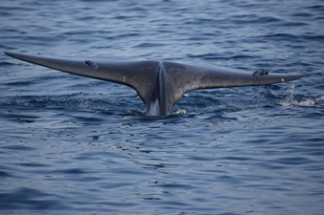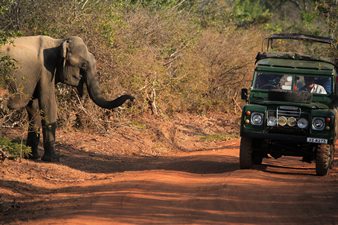
 Departure November – April
Departure November – April
Sri Lanka is known for its game but did you know that it is home to Blue Whales? The largest animal to have ever lived on our planet, the Blue Whale can be seen in Mirissa, South Island, one of the world’s top spots for watching them. This tour combines both sea with safari to give you an up close look into the wildlife of Sri Lanka. Visit national parks to view elephants, leopards and sloth bears. Bird watching in Sinharaja offers you 41 different species of Bird Flock. Cross the Kelani River in a dugout canoe to view fauna and flora. Sri Lanka Safari with Whales is a chance to see its wild by land and by sea.
Day 1 – Arrive Colombo – Mirissa
(By surface 3.5 – 4 hours)
Upon arrival you will be met outside of ground transportation after clearing customs by our representative who will be holding a sign with your name on it and driven to your hotel. Remainder of the day is at leisure to relax by the beach. Overnight at Paradise Beach Club (3 nights)
Day 2 & 3 – Mirissa
You begin your exploration with a morning drive with your naturalist to the Mirissa Fishery’s Harbour to experience the sea in a spacious and comfortable boat. Blue Whales in concentrations not seen elsewhere in the world would be the highlight of the day. A concentration of Blue Whales of this nature is something which whale watchers can only dream about. During the migration, Blue Whales are seen relatively close to shore as the continental shelf is narrow to the South of Dondra. The remainder of the day is at leisure by the beach. Or you can visit Galle Fort. Overnight in Mirissa
Day 4 – Mirissa – Yala
(By surface 4 hours)
After breakfast, drive to Yala. Take an afternoon game drive at Yala National Park to see Yala’s big three – Leopard, Sloth Bear and Asian Elephant. A recent study has shown that Yala Block I has one of the highest densities of Leopards in the world. Other wildlife seen includes Mugger Crocodile, Jackal, Monitor Lizard, Spotted Deer, Black-Naped Hare, Asiatic Buffalo and Sambar. The park is also good for dry zone specialties like Indian and Great Thick- knees, Sirkeer and Blue-faced Malkohas and Malabar Pied Hornbill. A day’s birding in the park, during the winter months can yield 100+ species. Overnight at Jetwing Yala (3 nights)
Day 5 – Yala
Take an early morning and afternoon safari at Yala National Park to spot Leopard and other wildlife. Overnight in Yala
Day 6 – Yala
Discover Bundala National Park. Bundala is a fascinating wetland home for 150 species of winter migrant and resident birds. Bundala is the only ‘Ramsar’ wetland of Sri Lanka. Among the larger water birds you could also see Lesser Adjutant, Painted Stork, Asian Openbill, Eurasian Spoonbill, Black-headed Ibis and Wooly-necked Stork. Waders that can be seen at Bundala include Pacific Golden, Lesser Sand and Greater Sand, Little Ringed, Kentish and Little Ringed Plovers, Little Stint, Marsh, Common, Wood and Green Sandpipers. You could also see the two odd-looking Eurasian Thick-knee and Great Thick-knee in addition to Eurasian Curlew, Black tailed Godwit, Common Snipe, Red-necked Phalarope, Pintail Snipe and Ruddy Turnstone. Mugger and Saltwater Crocodile may also be seen during a safari to Bundala.
In the afternoon, take one last game drive in Yala National Park in search of fLeopard and other wildlife. Overnight in Yala
Day 7 – Yala – Udawalawe
After breakfast, drive to Udawalawe. Afternoon game drive in Udawalawe National Park for viewing Asian Elephants and dry-zone birding. In a visit to Udawalawe National Park close to 50-60 Elephants can be seen and the park is good for birds of prey and we will look for Grey-headed Fish Eagle, Black-shouldered Kite, Changeable Hawk Eagle, Crested Serpent Eagle, White-bellied Sea Eagle, Shikra, Common Kestrel, Brown Fish Owl and Western Marsh Harrier. Also look for Malabar-pied Hornbill, Thick-billed Flowerpecker, Plum-headed Parakeet, Common Hoopoe, Sirkeer Malkoha, Blue-faced Malkoha, Little Green Bee-eater, Barred Buttonquail (sub species leggei, which is one of the 18 sub species worldwide!), Indian Silverbill and Black-headed Munia. Also look for the migrants which include Black-capped Purple Kingfisher, Blyth’s Pipit and Orange-headed Thrush. Overnight at Grand Udawalawe Hotel (1 night)
Day 8 – Udawalawe – Sinharaja
(By surface 5 hours)
After an early breakfast, drive tor Sinharaja. In the late afternoon trek in thet Sinharaja Rainforest, A UNESCO World Heritage Site for lowland endemics and mixed species bird flocks. According to a study of the mixed species bird on average 42 individual birds occur in the flocks, which makes this world’s largest mixed species bird flock. The mixed species Bird flock study of Sinharaja forest has been continuing since 1981 and is considered as the World’s longest studied bird flock study. Birding highlights include Red- faced Malkoha, Sri Lanka Blue Magpie, White-faced Starling and Scaly Thrush. A variety of other rainforest specialists including Green Vine Snake, Green Pit Viper, Sri Lanka Keelback, Giant Wood Spider and an array of butterfly and dragonfly species may also be observed. Overnight at Martins Simple Lodge (3 nights)
Day 9 & 10 – Sinharaja
Morning and afternoon walks into the Sinharaja Rainforest to view bird species. Overnight in Sinharaja
Day 11 – Sinharaja – Nuwara Eliya
(By surface 5 hours)
After breakfast, drive to Nuwara Eliya. Afternoon, visit Victoria Park in search of Yellow-eared Bulbul, Sri Lanka Hill White-eye and Dull blue Flycatcher. Also visit a nearby wetland for proposed endemic Black-throated Munia, Paddyfield Pipit, Pied Bush Chat, Pintail Snipes, Zitting Cisticola, Plain Prinia, Blyth’s Reed Warbler and if lucky Pallas’s Grasshopper Warbler. Overnight at Jetwing St. Andrews Hotel (2 nights)
Day 12 – Nuwara Eliya
Morning, visit Horton Plains National Park to see cloud Forests, montane landscapes and rare montane fauna, which include the endemic Rhino-horned Lizard, which was featured in Charles Darwin’s monumental work on evolution. Mammal highlights include Bear Monkey, Giant Squirrel and Sambar. Walk though the grasslands and cloud forests to a popular viewpoint known as World’s End, which is an escarpment with an 870 m drop. We also look for montane endemics Yellow-eared Bulbul, Sri Lanka Bush Warbler, Sri Lanka Wood Pigeon, Sri Lanka White Eye, Dull Blue Flycatcher and if lucky the scarce montane endemic, Sri Lanka Whistling Thrush. Also look for Indian Blue Robin, Zitting Cisticola, Pacific Swallow, Mountain Hawk Eagle, Crested Goshawk and Indian Pied Bush Chat. Afternoon, visit Hakgala Gardens for habituated troops of Purple-faced Leaf Monkey, montane endemics and other highland species.
DAY 13 – Nuwara Eliya – Kitulgala
(By surface 3 hours)
After breakfast, drive to Kitulgala. Afternoon, cross the Kelani River in a dugout canoe and reach the Kelani Valley Forest Reserve, which is a lowland tropical rainforest rich in endemic fauna and flora. The Kelani Valley Forest Reserve is ideal for any missed lowland endemics such as Sri Lanka Myna, Green-billed Coucal, Spot- winged Thrush, Sri Lanka Blue Magpie, Sri Lanka Spurfowl, Brown-capped Babbler and Red- faced Malkoha. Also look for Hill Mynah, Lesser Yellownape, Crested Drongo, Greater and Black-rumped Flamebacks, Black-capped Bulbul, Black Bulbul, Yellow-browed Bulbul, Velvet- fronted Nuthatch and Black Eagle. As the dusk falls look for the sub continental endemic Sri Lanka Frogmouth. Overnight at Plantation Hotel (2 nights)
DAY 14 – Kitulgala
Early morning and late afternoon, look for the endemic birds including Serendib Scops Owl, Chestnut-backed Owlet, Green-billed Coucal, Sri Lanka Spurfowl and other rainforest specialties including lizards, a variety of dragonflies, butterflies and amphibians at the Kelani Valley Forest Reserve. Overnight in Kitulgala
DAY 15 – Depart Kitulgala
(By surface 2 hours)
You are met at your hotel and driven to the airport for your departure flight homebound.









